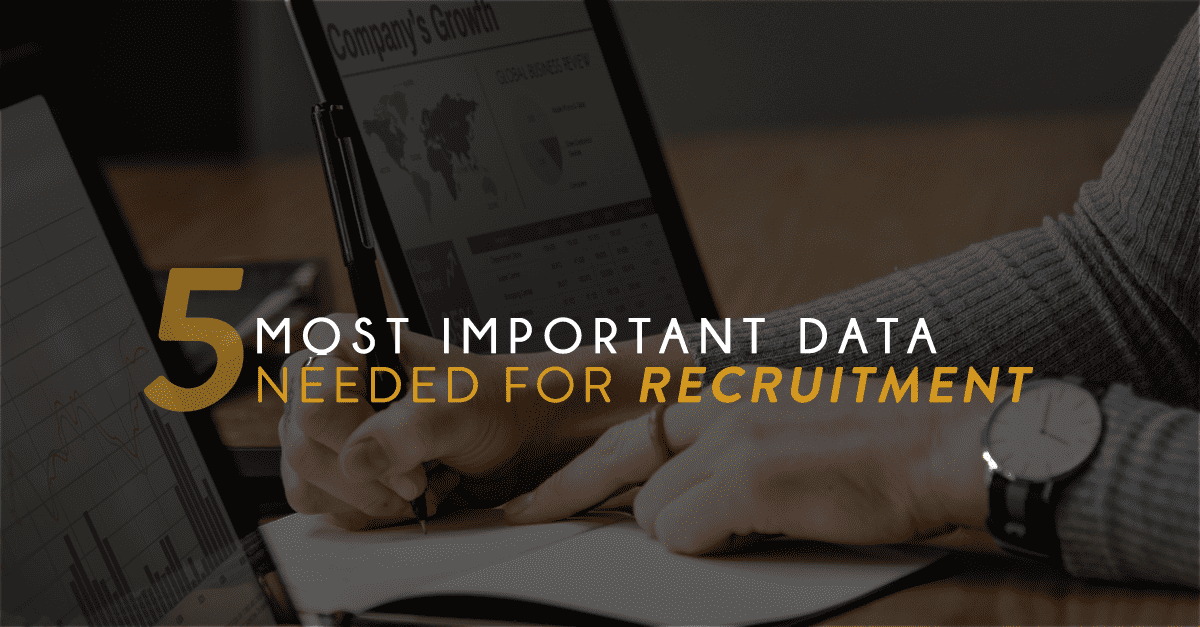Big Data is becoming one of the biggest tech buzzwords over the past decade. Every company, whether big or small, is wondering how they can use big data to get to know their employees and create a corporate setup that suits their needs.
Due to big data analytics, candidate sourcing and recruitment have undergone a lot of changes over the past few years. At this point, it cannot be denied that big data is no longer just a technological issue but also a strategic one for organizations.
Leveraging the use of big data to your company’s advantage
One of the top challenges that organizations face is finding and keeping talented candidates. For so many years, organizations have collected information on their employees but haven’t been able to do much with the data.
Each company has their own untapped data resources. Companies are already producing streams of data; however, they are unable to capture any useful insights from their own data resources.
The data they have on hand might have been scattered among different departments in the organization, or somehow, there are just no scientific formulas that are readily available to make the data meaningful for them.
It is crucial for organizations to identify their untapped data resources accurately. This will help them have a better understanding of their own needs and capabilities. Eventually, they can adopt a talent-centric and data-driven approach to their HR practices in the near future.
Recruiters and HR personnel are now using big data as an essential tool in making informed decisions on talent acquisition, including sourcing and recruiting. Big data is transforming HR talent acquisition practices from being a reactive function to a proactive function that complements an organization’s business strategy.
Workforce science in the age of big data
Workforce science is an emerging field that uses big data analytics in human resource management. In an interview with The New York Times, Peter Cappelli, the Center for Human Resources director at the University of Pennsylvania’s Wharton School, championed this new discipline.
He noted that “This is absolutely the way forward. Most companies have been flying completely blind.”
Big data is already becoming a game-changer in the HR management field. This is why exploring the field of workforce science is a choice that an organization needs to seriously consider.
Workforce science involves a multidisciplinary process that a firm will have to initiate within the organization. This will help them gain some leverage in today’s competitive candidate-driven market.
Executing top-notch recruitment strategies with the help of workforce science is an advantage that will eventually make an organization succeed in outperforming their competitors.
With big data at the helm of the recruitment field, companies are now starting to use big data analytics strategically – by making informed decisions on candidate sourcing and recruiting.
Here are several applications of big data analytics in candidate sourcing and recruiting:
- Recruiters can access market-specific compensation data to compare salary ranges among competitors.
To compare how salary ranges measure up against competitors, recruiters have access to industry data that will give them an idea of how a specific company’s compensation data rank among their peers.
This will come in handy for certain situations when there is a skills shortage in a particular industry. By raising a firm’s salary to the median after comparing compensation data to industry standards, an organization can attract more qualified candidates to their vacant position.
It will also prompt other job seekers to learn the required skill set for that profession so they can invest in training for long-term career advancement.
- Management can analyze current and past workforce to make informed choices regarding future hiring decisions.
With the help of big data and workforce science, companies are becoming increasingly adept in analyzing their current and past workforce to make informed hiring decisions.
Using data analytics on their own workforce data, companies can now use the results of this analysis to implement systemic changes and realignments of their recruitment strategies.
Data analytics can also find out when a team member has a high risk of leaving the company. This will prompt the manager to pay more attention to their staff and help them intervene before outstanding employees are recruited by other companies.
It will also ensure that every employee will be rewarded for the corresponding efforts that they have invested in the organization — thereby increasing the incentives for these workers to stay with their current employer.
- Data analytics can bring about actionable insights on how managers can better support their staff.
Nowadays, big data can not only help recruiters find the best candidate for a firm’s vacant positions, but it can also be used to make actionable insights about future workforce needs.
Using insights garnered from predictive data analysis, managers are given “evidence-based” data to learn the degree of an employee’s dedication to their job and whether or not they are promotable.
These insights can be a powerful tool for recruitment and employee retention since management are now equipped with the knowledge of how each employee contributes to the organization. Thus, they can make data-driven decisions on promotions, incentive plans, and workplace policies.
- Using big data analytics can significantly improve a firm’s time-to-hire and cost-per-hire by evaluating their own talent acquisition processes.
Companies are now starting to realize the value of workforce science when it comes to improving the operational efficiencies of their talent acquisition strategy.
Big data analytics is now being utilized not just to find a better candidate, but also to cut costs and reduce efficiencies in applicant sourcing and recruiting.
A company often invests in a variety of recruitment sources to attract potential job applicants. These may include posting vacancies on the company career sites, job boards, social media, and even hiring staffing agencies.
In a span of one year, these services would most likely generate a significant number of performance-based data. If the data from these various recruitment sources will be aggregated and analyzed, the firm can find out which among these sources are the most effective and efficient.
Based on performance data, the organization can now invest in their best recruitment sources. This ensures that a firm’s talent acquisition budget is being spent at the most strategic platforms.
- Companies can use big data to amplify specific employee behaviors that foster great organizational culture.
Gone are the days when organizational culture is considered an elusive and intangible asset in the company. In the era of big data, workforce science can provide a set of quantitative data on organizational culture. These data can also include valuable employee feedback.
Data analytics can help identify an employee’s values, beliefs, and attitudes. Upon knowing these insights from employees, companies can highlight specific employee behaviors that they want to amplify and nurture among organizational members. These data can help shape the foundations of a great organizational culture.
Consequently, it also allows organizations to identify characteristics among their job applicants and see whether they can fit into the organizational culture. It will eventually speed up the onboarding process and increase employee retention. After all, a great organizational culture is a significant factor in an employee’s tenure in the organization.
Big data as the next frontier for recruitment innovation
Since these data analytics software may tend to “take over the recruiter’s job,” some skeptics may be led to believe that big data is a threat to the HR industry. Sysgen RPO firmly believes that advancements in data technology will not diminish the role of the professional recruiter, it will just enhance it further.
Sysgen RPO adheres to the belief that you can never replace the “personal or human touch” of the recruitment process. It adds to the necessary element of value-laden judgment and intuition that are both required to assess a potential candidate accurately.
The use of workforce science and big data analytics is merely the next step in the innovation of the recruitment process. Recruiters in the HR field are now slowly transitioning from administrative-focused jobs to consultancy-based talent advisory positions.
Big data will not dehumanize the field of talent acquisition, but instead, it will just empower more recruiters to find the right candidates who are best suited for your company’s vacancies.
References:
Bania, M. (2015). BIG DATA Applications in Recruitment. HR Professional, 32(2), 45–46. Retrieved from http://search.ebscohost.com.ezproxy.upd.edu.ph/login.aspx? direct=true&db=bsu&AN=110796859&site=ehost-live
Big Data, Trying to Build Better Workers. (2019). Nytimes.com. Retrieved 10 January 2019, from https://www.nytimes.com/2013/04/21/technology/big-data-trying-to-build-better-workers.html
Rind, M. (2018). How Big Data Can Help You Find and Hire the Most Elusive Talent. Entrepreneur. Retrieved 10 January 2019, from https://www.entrepreneur.com/ article/315930
Roa, J. (2018). Celebrating 27 Years of Recruiting Excellence. Sysgen RPO. Retrieved 13 January 2019, from https://sysgen-rpo.com/celebrating-27-years-recruiting-excellence/
Segal, L., Goldstein, A., Goldman, J., & Harfoush, R. (2014). Deploying Big Data to Recruit and Retain Talent. Ivey Business Journal, 1–4. Retrieved from http://search.ebscohost.com.ezproxy.upd.edu.ph/login.aspx?direct=true&db=bsu&AN=95698409&site=ehost-live
Tayal, R. (2014). Technology changing the face of HR. Human Capital, 69. Retrieved from
http://search.ebscohost.com.ezproxy.upd.edu.ph/login.aspx?direct=true&db=bsu&AN=109266849&site=ehost-live
Vereckey, B. (2013). The Talent Within. Bloomberg Businessweek, (4328), S1–S3. Retrieved from http://search.ebscohost.com.ezproxy.upd.edu.ph/login.aspx?direct=true&db =rgl&AN=88364591&site=ehost-live






















